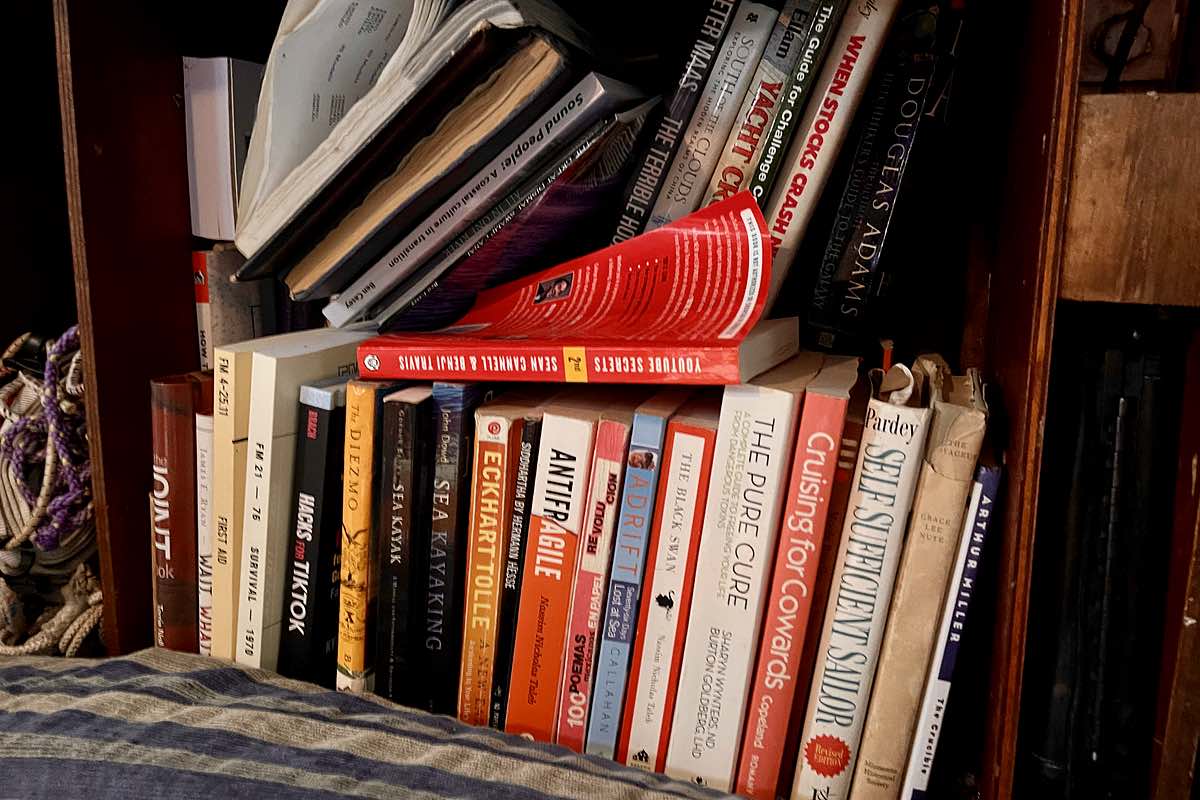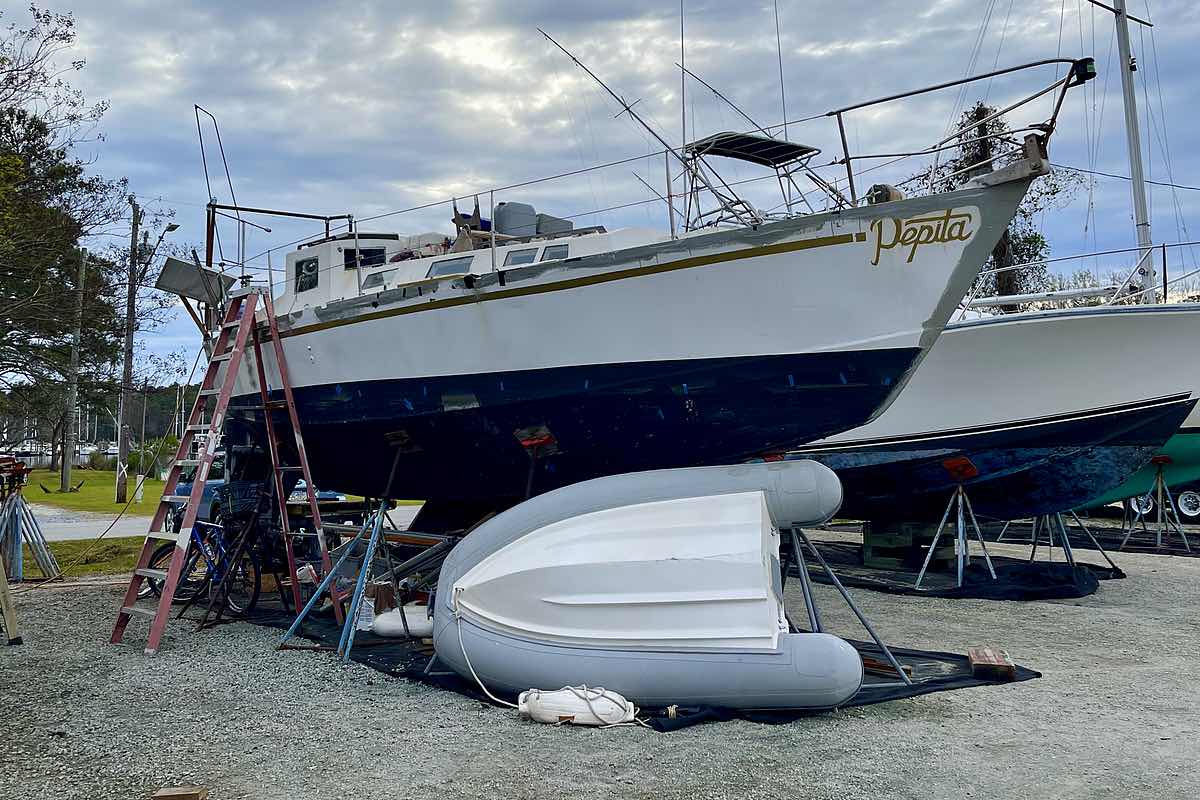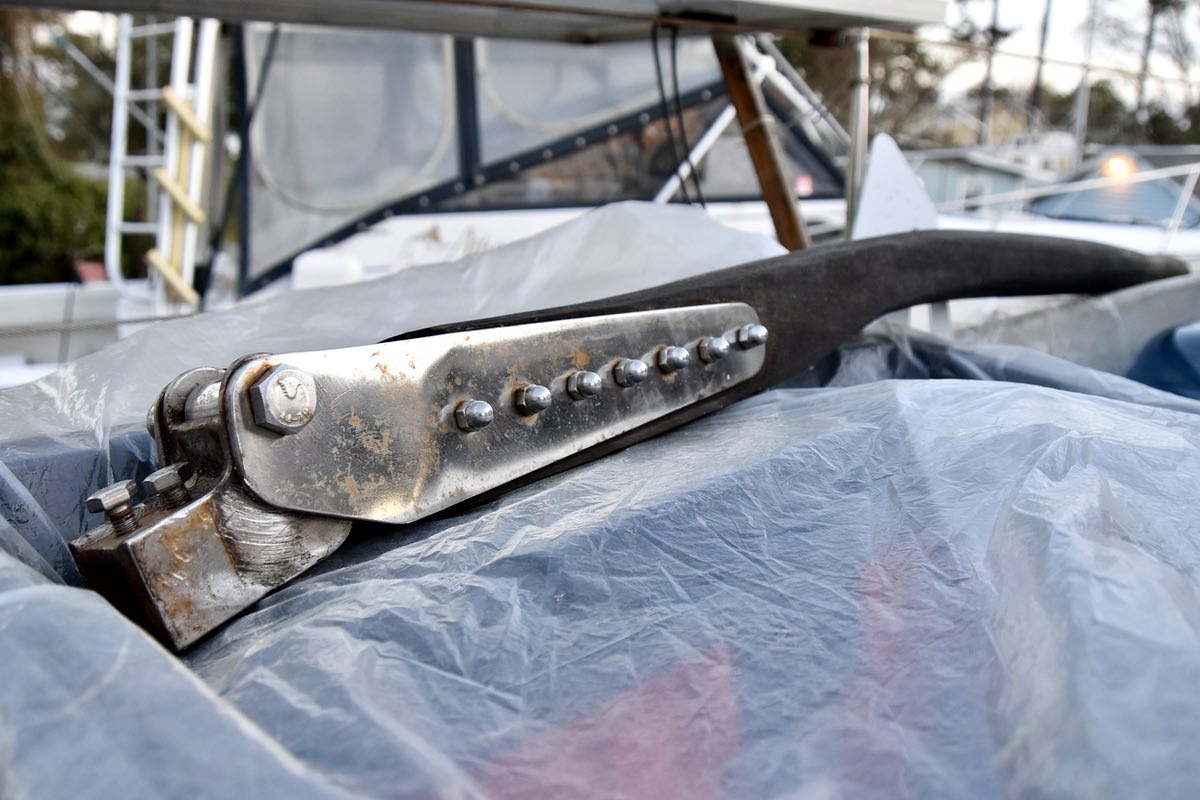It's Monday January 5, 2026

Lots of boats come to Oriental, some tie up at the Town Dock for a night or two, others drop anchor in the harbor for a while. If you've spent any time on the water you know that every boat has a story. The Shipping News on TownDock.net brings you the stories of the boats that have visited recently.
March 22, 2023
Just centimeters of filth everywhere,” says Tim Sussmann, “I was finding legos and Barbie dolls everywhere. I can’t imagine it – I can barely keep it somewhat orderly myself.”
Looking down into SV Pepita.Tim sits at a folding table below decks on SV Pepita, picking over a small spread of cheese and crackers. He’s describing the interior condition of his boat when he first took possession of her in Guatemala in the first half of 2022.
The 33 ft steel hulled Reinke Taranga was built in 1980. When he found it, a family of four from Germany were calling it home. Though Tim has deconstructed most of Pepita’s interior, there are still signs of the family tenure – a homemade, heart-shaped patch on a cushion and instructions, written in German, next to the companionway.
The main cabin is filled with trinkets from friends and Tim’s travels.When Herz aus Gold, Heart of Gold as the family had named her, went up for sale in Río Dulce, Guatemala, Tim was living in Brazil.
He had a fried in Guatemala check on the boat for him. “They’re asking too much,” he was told, “but if you offer them this price, then it’s worth it for you to come have a look.”
Tim was looking for something specific – a boat that could take him across the Atlantic, and eventually through the Northwest Passage. He wanted a steel-hulled boat and he needed it to be inexpensive.
A hand-sewn patch from the previous owners.Another reminder of the former owners: instructions written in German.After some negotiation with her owners, Herz aus Gold fit both criteria. Tim sold the motorcycle he’d used to travel around Brazil, gathered up his few belongings, and left for Río Dulce.
Tim knew he’d have to do a deep cleaning of the interior, but after hauling the boat, he also discovered some other problems.
“We pulled the boat out and I found a bunch of other things, a bunch of rust,” he says, “I took a hammer to a certain spot and it just went through.”
Tim spent three months in Guatemala, repairing the boat, and prepping her for a voyage north. He also renamed her. From Herz aus Gold to Pepita de Oro; heart of gold to gold nugget. “I wanted to call her Nugget, but then I was like, ‘everyone’s going to think of Chicken Nugget.”
Tim recounts his sailing experiences.Naming a steel boat Gold Nugget also had other inauspicious implications: “Gold nuggets sink really fast.” So Tim settled on Pepita.
She’s not technically Tim’s first boat – that one came from some hippies who traded him room and board for his handyman skills.
But the Reinke Taranga 33 is the one he’s decided to take across the ocean.
“Supposedly Reinke was a grouchy old man, and he was a boat builder,” says Tim. “He was very strict about people not messing with his boat [design].” The German family would have bought the plans and either had the boat built or would have built it themselves.
Personal mementos are tucked into corners and taped on walls.Tim explains the crab’s origin.It got the German family to Guatemala. Tim hoped it would get him to New York for his sister’s wedding.
“I meant to just pass through town,” he says of his trip to Oriental. But the day he was going to leave, it was too windy. He’d heard it was nicer on the other side of the Oriental Bridge, and with a 36 ft tall mast (to the deck), didn’t think much of it. Only he didn’t realize at the time that Pepita’s air draft is 45 ft – the radio antenna occupied those few extra feet of situationally problematic space.
And so Tim and SV Pepita, like others before them, had a close encounter with the Oriental Bridge. It knocked the antenna and anchor light off the mast, stalling their trip north. The mast itself was ok.
The round-the-boat view.“I only had about $200 in my account, and I needed the antenna for communication.”
Having made it under the bridge (sans antenna) Tim anchored Pepita in Smith Creek. He’d need to find work to get a new antenna and be on his way.
Heading to Barcos restaurant, down from the dinghy docks, Tim found Homer Walden working on a wall of the building.
“I asked him if he could give me a job,” he said, “and it worked out.” Homer was happy with the work Tim produced and began sending clients his way. Tim also chanced to meet Gregory Bohmert at Clancy’s Marina and was able to rent a boat slip under the bridge to do repairs, and take advantage of the shore amenities.
Nets above the galley hold fruits and other kitchen essentials.Reading material, including the locally written book Sound People.Originally, Tim planned on finding work in New York. But work seems to have found him in Oriental. He decided to bide awhile in town, working as a handyman, while continuing repairs and upgrades to Pepita.
He did make it to his sister’s wedding in New York, though not by boat. He took the Greyhound bus.
Though Tim has travelled extensively through many different countries – by plane, boat, bicycle, motorcycle, and foot – the bus trip may have been one of the most unpleasant.
“It was the worse decision I’ve ever made.” The ride was supposed to take twelve hours. It became 24. “One bus was late and the transfer was wrong. And I was stuck [at the bus station] in Richmond, VA in the middle of the night.”
Tim sits on the companionway stairs of Pepita, coffee cup resting on his knee, discussing how he came to be in Oriental.In the mid 2010s, Tim left New York behind – having never sailed or traveled too extensively – by hopping on a plane to Papua New Guinea.
“I had a mentor – a professor in university who basically took me under his wing and was like, ‘Tim, you need to travel.’”
The encounter wouldn’t have happened, if Tim’s mother had not been determined her son would attend college. “I didn’t want to go to college,” he says. “My mother found a degree that looked somewhat interesting to me.”
That degree was in Expeditionary Studies at SUNY Plattsburg. It includes studies on environmentalism and the history of exploration, with a focus on leadership, planning, and risk management skills.
Tim is over 6 ft tall, a bit too tall for the forward berth. So some adjustments had to be made.Tim lays boards out over the head, then covers that with cushions to extend the berth.His mentor introduced Tim to the book that inspired his decision to go sailing, Tamata and the Alliance by Bernard Moitessier.
“He picked me out specifically. He’s like, ‘come, work on my farm.’ And I went and worked on his farm,” Tim says. “He’s the one who told me to read many other books and he was just like, ‘you need to travel. Have you bought your plane ticket?”
It became a common refrain, says Tim. ‘Have you bought your plane ticket? Have you bought your plane ticket? Have you bought your plane ticket?’
“And I finally bought my plane ticket.”
Tim looking out from the stern.Tim has since crossed oceans, helping on a boat delivery from Indonesia to Cairns, Australia for a month, working on a crabbing vessel, learning to sail a 50 ft racing sloop on a delivery trip from Malaysia, with stops in Honduras, Brazil and more along the way.
The racing sloop delivery was his first time sailing – “I had a spoiled taste, really.” The sloop continuously travelled at 10-15 knots. “I thought ‘wow. Sailing’s great. It’s not that slow, I don’t know what everyone’s talking about.’”
Though an enjoyable introduction to sailing, the sloop wasn’t how Tim really learned to sail. That was the result of his friend Joaquin, a sailing coach in Argentina. Tim lived on a boat with Joaquin in Río Dulce for a time before finding Pepita.
Their boat’s tender was an Optimist dinghy. They took it out every day, doing drills and working through the finer points of sailing.
Pepita sits at Zimmerman Marine. Tim had her hauled to continue repairs.Tim points out a small hole in the hull.“He taught me how to sail. The other captain was sort of just like, ‘we need to deliver the boat, so you do this to make the boat go fast,’” he says. “Joaquin was like, ‘okay, Tim, these are the things that you need to do to make the boat sail properly.”
The lessons were important ones. Not because of the obvious, but because of Tim’s plans.
He wants to travel. And take his home with him. “I have a little home that I can arrive in somewhere and explore.”
More importantly, Tim wants to travel to Africa.
“I really want to go to Africa and leave my boat, bicycle around Africa and come back to my boat – It’s like a little home base. When hitchhiking or on a dirt bike or a bicycle, you’re so exposed and there’s no removal unless you pay money for an apartment or AirBnB to remove yourself from that situation.” Tim is a self-described budget traveler “I’d either be camping or somebody would be welcoming me in their home and I just got tired of that because there was no reprieve.”
Tim and Pepita in the yard at Zimmerman Marine. He’s constructing an arch on the stern to hold solar panels.The tiller resting in the cockpit.As for sailing to Africa – it’s the same reason he started his travels in Papua New Guinea. Tim has an interest in people and cultures that still retain a hold on their traditions and customs – on “cultures that are very close to the earth.” He’s thinking of heading to Senegal, or perhaps Namibia and Botswana.
There is a greater focus to Tim’s curiosity, and it seems to be at the heart of his travels.
It’s the stories. Oral traditions and individual accounts.
“There’s old wise men and old wise women … and everyone comes and gathers around a fire at the end of the night and they tell a story. And this story has actual meaning and sort of guidance within in that helps a person navigate their life.” Tim says he feels that coming together of generations to share a story, to share memory and space together, is lost in our culture.
Tim points out the corrosion on a sacrificial anode (or boat zinc).And Tim would like to find that for himself, to be that – “to be a storyteller.”
“If I could give back to the world,” he says, “this is what calls to my heart. I love being a nomad. I love being this person that goes from place to place, to mesh with the society, become part of it and experience life in a new way. And people learn about me and I learn about them and we just grow together. And I love that.”
Pepita has since been hauled out at Zimmerman Marine. Tim is checking her over for damage while working on further repairs.
So far he’s found one hole in the hull, along with a few other concerning spots where the deck meets the hull. Friends from back home are driving or flying down to help as the work progresses.
SV Pepita anchored in Oriental Harbor.Tim is hoping to have everything ready to sail in the next few months. He’d like to make the crossing with another experienced sailor, or maybe introduce some of his friends to life aboard. Current estimates are a two month crossing, though he’s hoping for less.
He’s already gotten a jump on the storytelling. Tim has a YouTube channel dedicated to his travels, his boat, and who and what he encounters along the way.
Much of his current life circles back to the stories, and to writer Bernard Moitessier. “He inspired me. He adventured and gained a lot from life … from the perspective of a sailboat.” Tim says. “I love that.
“I would love to be able to take my experiences, and share it with people.”
Tim heads to shore.Related Links• Tim’s YouTube Channel, Sailing Pepita
Story & photos by Allison DeWeese.



























